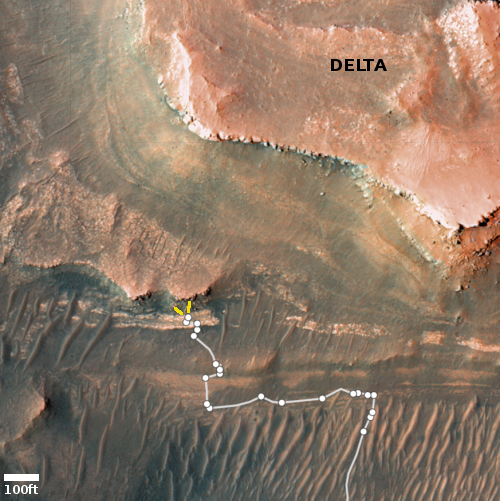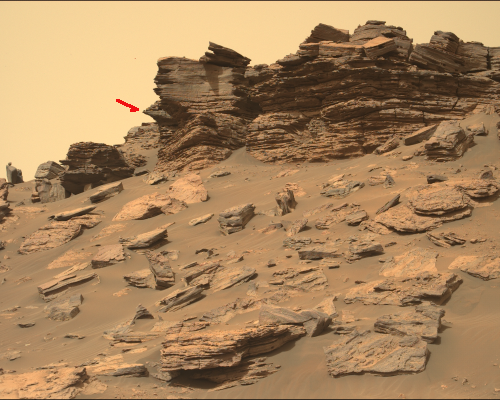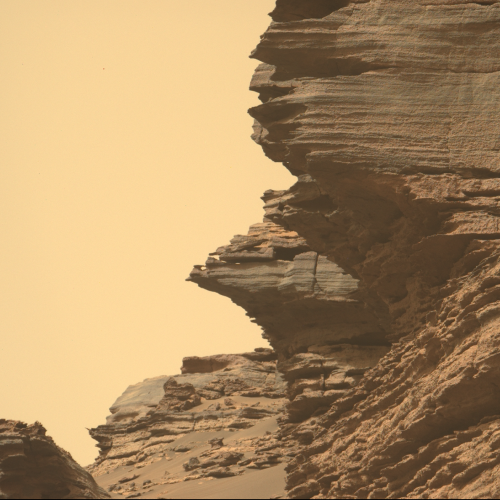Perseverance gets close to its first cliff
Time for some cool images from Perseverance! The rover, now on Mars for more than a year, has finally begun its journey up the delta of material that some time in the past flowed through a gap in the rim of Jezero Crater. In doing so, it has also finally got close to a nearby cliff, within fifty feet or so, and used its high resolution left mast camera (mastcam) to take the photos to the right. The first, cropped and reduced to post here, was a wider shot taken on June 10, 2022, with the red arrow pointing to the part of the cliff featured in the second image below, taken on June 12, 2022, after the rover had moved in closer. This second photo is also cropped and reduced to post here.

Click for interactive map.
As with the geology that Curiosity is seeing in Gale Crater, the number of layers is astonishing. From orbit the delta appears almost as if it was one event, a blob of mud and material pushed out catastrophically. Up close, it is quite evident that instead the delta was laid down over eons, with many events each placing down a new layer.
Those layers are so thin and many that if you look close, you can see that some thin sections have been eroded away between others, leaving gaps. This is very evident at the pointy end that extends outward the most. In several spots you can see through that pointy ends to the sky beyond.
Were the events that created these many thin layers seasonal, occurring each year when the atmosphere was thicker and the change of seasons had a greater impact? Or were they tied to longer term cycles, such as the changes in Mars’ rotational tilt or obliquity, which can vary from 11 to 60 degrees? Scientists today believe many of the geological features now identified on Mars were caused by the latter cycles.
It is Perseverance’s job to find out which, here in Jezero Crater. The overview map to the right provides some context. The yellow lines indicate the area covered by the wider photo above. Though the rover’s science team have not yet published their planned route up the delta, it seems very likely Perseverance will be sent up the gap that is presently to its right.
Ingenuity still sits on the crater floor, about a half a mile to the east. Its engineering team is still working to get its batteries charged as well as rewriting its flight software to deal with the failure of one sensor. If these fixes can be achieved, the plan is to fly the helicopter that half mile or so to the west so it is positioned at the entrance to the gap, thus providing good line of sight communications between it and the rover as Perseverance travels upward.
On Christmas Eve 1968 three Americans became the first humans to visit another world. What they did to celebrate was unexpected and profound, and will be remembered throughout all human history. Genesis: the Story of Apollo 8, Robert Zimmerman's classic history of humanity's first journey to another world, tells that story, and it is now available as both an ebook and an audiobook, both with a foreword by Valerie Anders and a new introduction by Robert Zimmerman.
The print edition can be purchased at Amazon or from any other book seller. If you want an autographed copy the price is $60 for the hardback and $45 for the paperback, plus $8 shipping for each. Go here for purchasing details. The ebook is available everywhere for $5.99 (before discount) at amazon, or direct from my ebook publisher, ebookit. If you buy it from ebookit you don't support the big tech companies and the author gets a bigger cut much sooner.
The audiobook is also available at all these vendors, and is also free with a 30-day trial membership to Audible.
"Not simply about one mission, [Genesis] is also the history of America's quest for the moon... Zimmerman has done a masterful job of tying disparate events together into a solid account of one of America's greatest human triumphs."--San Antonio Express-News
Time for some cool images from Perseverance! The rover, now on Mars for more than a year, has finally begun its journey up the delta of material that some time in the past flowed through a gap in the rim of Jezero Crater. In doing so, it has also finally got close to a nearby cliff, within fifty feet or so, and used its high resolution left mast camera (mastcam) to take the photos to the right. The first, cropped and reduced to post here, was a wider shot taken on June 10, 2022, with the red arrow pointing to the part of the cliff featured in the second image below, taken on June 12, 2022, after the rover had moved in closer. This second photo is also cropped and reduced to post here.

Click for interactive map.
As with the geology that Curiosity is seeing in Gale Crater, the number of layers is astonishing. From orbit the delta appears almost as if it was one event, a blob of mud and material pushed out catastrophically. Up close, it is quite evident that instead the delta was laid down over eons, with many events each placing down a new layer.
Those layers are so thin and many that if you look close, you can see that some thin sections have been eroded away between others, leaving gaps. This is very evident at the pointy end that extends outward the most. In several spots you can see through that pointy ends to the sky beyond.
Were the events that created these many thin layers seasonal, occurring each year when the atmosphere was thicker and the change of seasons had a greater impact? Or were they tied to longer term cycles, such as the changes in Mars’ rotational tilt or obliquity, which can vary from 11 to 60 degrees? Scientists today believe many of the geological features now identified on Mars were caused by the latter cycles.
It is Perseverance’s job to find out which, here in Jezero Crater. The overview map to the right provides some context. The yellow lines indicate the area covered by the wider photo above. Though the rover’s science team have not yet published their planned route up the delta, it seems very likely Perseverance will be sent up the gap that is presently to its right.
Ingenuity still sits on the crater floor, about a half a mile to the east. Its engineering team is still working to get its batteries charged as well as rewriting its flight software to deal with the failure of one sensor. If these fixes can be achieved, the plan is to fly the helicopter that half mile or so to the west so it is positioned at the entrance to the gap, thus providing good line of sight communications between it and the rover as Perseverance travels upward.
On Christmas Eve 1968 three Americans became the first humans to visit another world. What they did to celebrate was unexpected and profound, and will be remembered throughout all human history. Genesis: the Story of Apollo 8, Robert Zimmerman's classic history of humanity's first journey to another world, tells that story, and it is now available as both an ebook and an audiobook, both with a foreword by Valerie Anders and a new introduction by Robert Zimmerman.
The print edition can be purchased at Amazon or from any other book seller. If you want an autographed copy the price is $60 for the hardback and $45 for the paperback, plus $8 shipping for each. Go here for purchasing details. The ebook is available everywhere for $5.99 (before discount) at amazon, or direct from my ebook publisher, ebookit. If you buy it from ebookit you don't support the big tech companies and the author gets a bigger cut much sooner.
The audiobook is also available at all these vendors, and is also free with a 30-day trial membership to Audible.
"Not simply about one mission, [Genesis] is also the history of America's quest for the moon... Zimmerman has done a masterful job of tying disparate events together into a solid account of one of America's greatest human triumphs."--San Antonio Express-News




These really are cool images. So much of what we see on Mars looks so much like the badlands area of Arizona, New Mexico and Utah, but the materials and processes seem to not be very similar.
I wonder what it will take to come up with flying camera platforms at higher elevations to start filling in the details between the up close imagery we get from the rovers and what we get from orbit.
What I find strange is the similarity of these water deposited sandstones to the wind deposited strata … At least visually…. The differentiation between the layers is dramatic, in both geological areas,and they look surprisingly similar.
I live in an area full of “old red sandstone” and see erosion and layers of a similar nature, but obviously less extreme.. there are “sticky out bits” ( I don’t know the technical terms!) But much smaller, no doubt because of gravity difference.
My guess is that the material making up the strata is of similar content.. even if the process depositing it is different and the erosion process remains the same, giving similar results.
My hope is that these layers of old red sandstone contain evidence of, perhaps even fossils of ancient life…. As I’m sure we all do.
David Eastman, yep I keep seeing location shots from the original Star Trek!
Vasquez Rocks!
https://www.lamag.com/culturefiles/10-star-trek-filming-locations-you-need-to-visit-before-the-new-series-premieres-in-2017/
Flight #29 apparently successful.
https://twitter.com/sfsholes/status/1536419606599852032
I’m terrible at seeing elevation in satellite images. That last one looks (to me) as if the dune things are running vertically up a cliff, which is clearly not the case given the rover path. I’d probably be better at it if, all those years ago, I had become a Satellite Imagery Analyst instead of a Combat Computer Programmer; the MOS was offered. Or I would have made a terrible analyst :)
The analogy I’ve come up with: Martian mesas (for lack of a better word) are like good pastry: Many thin, separated layers. Earth mesas are pop tart pastry: Dense and heavy. From a distance, they’re both pastry, but up close there are significant differences (due to more butter and colder temperatures on Mars, no doubt).